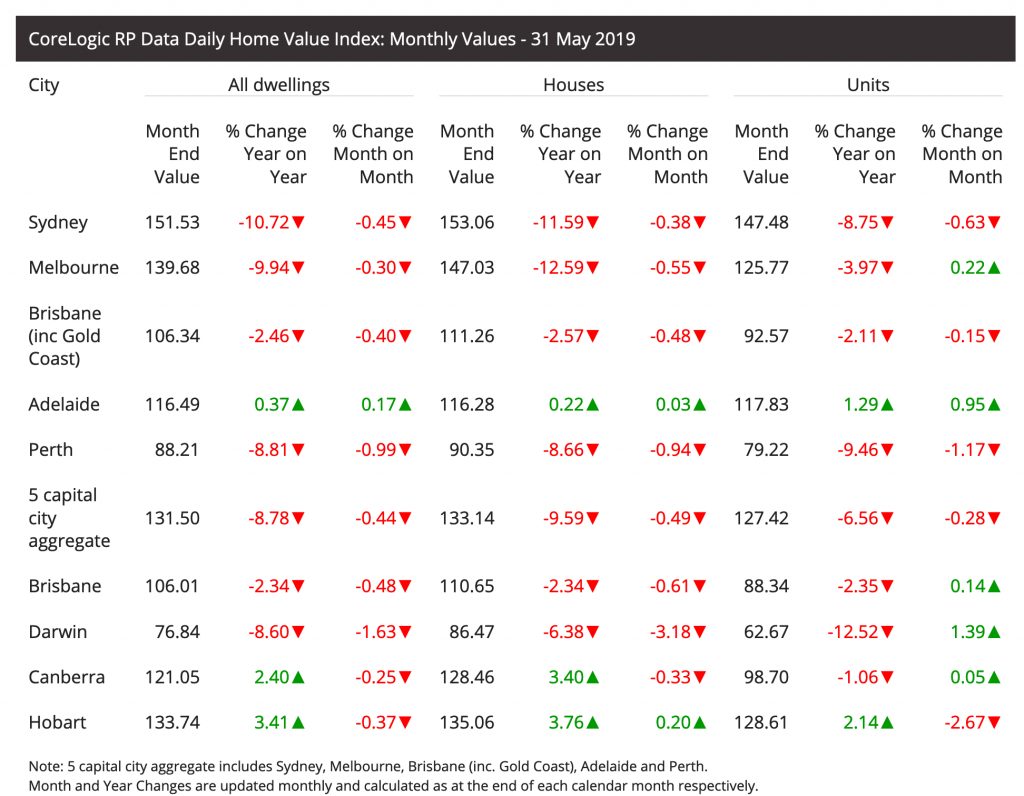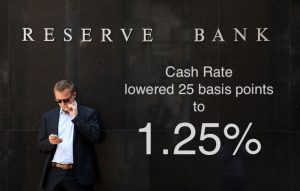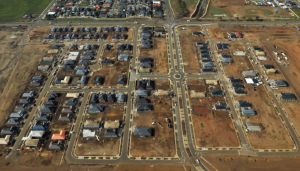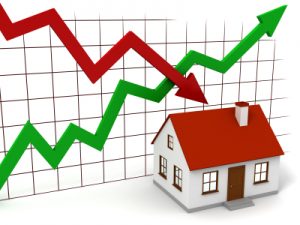Regulators, Mount Up!
Australian Property Market Update
4 June, 2019
Home prices continued to fall in the month of May, but at a slower pace than previous months. Although the property downturn continues to lose momentum, the RBA, APRA and Coalition Government are all galloping in to save the day.
Will it be enough to breath life back into a weary property market? It all comes down to how much more Aussies are willing (and able) to borrow.
Auction Clearance Rates
Many of those brave sellers who scheduled auctions post-election are being rewarded with rising auction clearance rates. Both Sydney and Melbourne saw a bump in buying activity on rising auction volume.
Here’s a look at preliminary and final auction data for the combined capital cities, plus Sydney and Melbourne, over the past five weeks:
Week Ending | Total Auctions | Capital City Average | Sydney | Melbourne | |||
Preliminary | Final | Preliminary | Final | Preliminary | Final | ||
5 May | 1,472 | 66.6% | 57.2% | 60.8% | 56.6% | ||
12 May | 1,218 | 65.6% | 59.0% | 56.8% | 55.7% | ||
19 May | 930 | 60.7% | 56.5% | 62.9% | 60.7% | ||
26 May | 2.041 | 69.9% | 62.1% | 62.9% | 59.6% | ||
| 2 June | 1,654 | 61.5% | Thursday | 66.1% | Thursday | 64.0% | Thursday |
Click the link in the Capital City Average columns to see the sources of the data.
There’s still some slippage between the preliminary results and final count, but the margin seems to be narrowing, especially in Melbourne. Depending on how the Sydney count plays out, this may be the first week in many months where both Sydney and Melbourne return a clearance rate above 60 percent.
Here are the latest preliminary auction results from CoreLogic for all the capital cities:
Source: CoreLogic
Home Prices 
Median dwelling prices continued to fall in May, but again, at a slower pace than the previous month. As you can see below, the rate of decline in Sydney and Melbourne has been decreasing steadily since January.
Here’s a look back at Corelogic’s recent monthly price movement data:
Sydney | Melbourne | Brisbane | Adelaide | Perth | Canberra | Hobart | |
January | -1.35% | -1.6% | -0.26% | -0.34% | -1.06% | +0.22% | -0.16% |
February | -0.97% | -1.00% | -0.25% | +0.04% | -1.46% | -0.19% | +0.82% |
March | -0.88% | -0.79% | -0.49% | -0.23% | -0.41% | +0.01% | +0.57% |
April | -0.70% | -0.58% | -0.42% | -0.13% | -0.39% | +0.42% | -0.90% |
May | -0.45% | -0.30% | -0.40% | +0.17% | -0.99% | -0.25% | -0.37% |
While the downward trend is improving in Sydney and Melbourne, Brisbane continues to fall at a brisk pace, and Perth has reverted back to a plunge downward, as in January and February. Canberra and Adelaide are mostly flat, while Hobart is showing signs of rolling over.
Here’s CoreLogic’s latest monthly median house price data:
 Source: CoreLogic
Source: CoreLogic
In terms of falls from the peak, which can be extracted from CoreLogic’s back series of data, the Sydney market, which peaked in July 2017, has now fallen 15.0 percent. Melbourne, which began falling in November 2017, is now down 11.5 percent from its highest level.
At the current rate of slowing decline, I expect Sydney and Melbourne house price movements to flatten out sometime in the next six months, likely pulled forward to the next three months by cheaper and easier credit and improved post-election sentiment.
RBA Shoots Down the Cash Rate
 After a strong dovish signal in a speech last month, Philip Lowe has finally started earning his wage, cutting the RBA cash rate to a historic low of 1.25 percent. It was August 2016, back when Glenn Stevens was the RBA chief, when we last saw a rate cut from our central bankers.
After a strong dovish signal in a speech last month, Philip Lowe has finally started earning his wage, cutting the RBA cash rate to a historic low of 1.25 percent. It was August 2016, back when Glenn Stevens was the RBA chief, when we last saw a rate cut from our central bankers.
Futures traders had already fully priced in the 25 basis point rate cut, with another cut of the same measure priced in for October as well. Many economists expect a follow-up rate cut to 1.00 percent sooner than that, at the August meeting.
As reported last month, the dovish policy is in response to a completely impotent CPI reading in the March quarter, bringing year-on-year inflation to just 1.3 percent. The RBA’s primary goal is to keep annual inflation somewhere between 2 and 3 percent, preferably now at the higher end.
Just how low will interest rates go? Well, AMP is expecting an RBA cash rate of 0.50 percent by mid-2020. If there’s ammunition left in the gun, the RBA will no doubt use.
Treasurer Josh Frydenberg gave a stern warning to the banks that the Australian public is expecting them to pass today’s rate cut along to consumers in full. Of course, that will also benefit the Coalition party, but yeah… it’s mainly for the consumers.
ANZ and Westpac have defied the Fryd by only passing along a portion of the rate cut to borrowers. Commonwealth Bank and NAB, along with most other smaller lenders, have all fallen into line and passed along the full quarter of a percent rate cut to borrowers.
But the big question looming in property investors’ minds is whether lower interest rates will open the door for more buyers to enter the market. Maybe with a little help from APRA.
APRA Pulls a Knife on Interest Rate Buffer
 Back in 2014, house prices were soaring higher and the RBA had plans to cut its cash rate far below 2.50 percent. Regulators needed a way to keep too much credit from flooding the housing market too fast, so APRA enforced an interest rate risk buffer on borrowers. Lenders were forced to assess the repayment capacity of borrowers not on the actual interest rate they would be charged, but at their current interest rate plus 200 basis points, or at 7 percent, whichever was higher. Although this was the official policy, APRA actually told lenders to be more strict than this, so most banks adhered to an assessment rate of 7.25 percent.
Back in 2014, house prices were soaring higher and the RBA had plans to cut its cash rate far below 2.50 percent. Regulators needed a way to keep too much credit from flooding the housing market too fast, so APRA enforced an interest rate risk buffer on borrowers. Lenders were forced to assess the repayment capacity of borrowers not on the actual interest rate they would be charged, but at their current interest rate plus 200 basis points, or at 7 percent, whichever was higher. Although this was the official policy, APRA actually told lenders to be more strict than this, so most banks adhered to an assessment rate of 7.25 percent.
In line with anticipated interest rate cuts from the RBA, APRA has now signaled it will slash this 7 percent minimum requirement, allowing lenders to review and set their own minimum interest rate floor for use in serviceability assessments. This likely means means that as the cash rate falls, serviceability of buyers will be assessed against the two percentage point buffer alone.
According to APRA Chair Wayne Byres…
“With interest rates at record lows, and likely to remain at historically low levels for some time, the gap between the 7 per cent floor and actual rates paid has become quite wide in some cases – possibly unnecessarily so.”
As interest rates fall, and for lenders who pass on the rate cuts, borrowers will likely end up being assessed on their ability to repay a 5.5 to 6.5 percent loan. That would mean a couple with two kids on $80,000 per year may be able to borrow about $120,000 more than they could before.

History has shown that most homebuyers aren’t really great at assessing their own risk. They let the banks do that for them, or at least that’s what they think the bank is doing. So this change will very likely increase the number of buyers entering the market.
However, before the flood gates will truly open, lenders will need the freedom to move away from verifying actual household expenses and instead return to the Household Expenditure Measure (HEM) for estimating expenses. As Philip Soos has accurately pointed out…
This is why the decrease in the RBA policy rate and APRA serviceability rate will do nothing to inflate house prices: the HEM is by far and away the largest factor in inflating loan sizes. Using verified expenses easily counteracts any benefit in cutting both rates. pic.twitter.com/IvH6VNqmz7
— Philip Soos (@PhilipSoos) May 26, 2019
Coalition Government Saddling Up First Homebuyers With a Carriage Full of Debt

The week prior to the election, in a bid to garner votes from a younger demographic, the Coalition threw out a scheme to lower the amount first homebuyers would need to save to buy a house. For up to 10,000 applicants (earning less than $125,000 a year or couples earning a combined income of less than $200,000), the Government has promised to guarantee the additional amount needed to reach a deposit of 20 percent, with the first homebuyer bringing as little as a 5 percent deposit. Qualifying buyers will therefore avoid having to pay Lenders Mortgage Insurance (LMI).
Why any first homebuyer would think it’s a good idea to borrow to buy a home at a 95 percent LVR in a falling market, I have no idea. Unfortunately, we as humans have not had a great track record of assessing risk during our twenties.
Case in point… Domain reported this week on five first homebuyers who went to war at auction for a two-bedroom apartment in Northcote. By the time the fourth buyer had bowed out, the winning bid was nearly $90,000 above the seller’s reserve. For perspective, the median price of a two bedroom unit in Northcote is $577,500.
Land Developers Desperate to Make Out Like Bandits
 Developers of struggling greenfield projects could be the most desperate for an uplift in sales from the recent regulatory stimulus. In Sydney and Melbourne, 27 percent of new homebuyers have been defaulting on their land purchases, unable to get finance due to more stringent lending criteria and low valuations.
Developers of struggling greenfield projects could be the most desperate for an uplift in sales from the recent regulatory stimulus. In Sydney and Melbourne, 27 percent of new homebuyers have been defaulting on their land purchases, unable to get finance due to more stringent lending criteria and low valuations.
For insight on just how much it sucks to be one of these buyers, click the video below to watch this 7News piece:
Hundreds of Melbourne families are panic selling housing blocks as they face financial ruin. @NickMcCallum7 #7NEWS pic.twitter.com/9ofC4RWWLx
— 7NEWS Melbourne (@7NewsMelbourne) May 20, 2019
Don’t Get Shot Down In a Blaze of Glory
 What does all of this mean for property investors?
What does all of this mean for property investors?
Although the regulators are coming to the property market’s rescue, the leading market indicators are still flashing red. Housing credit growth had another dismal month in April, growing at only 0.3 percent and residential building approvals fell sharply again over the month, down 4.7 percent.
While low credit growth tends to signal falling prices over the next six months, we’ll probably see the credit growth numbers improve once APRA’s changes go into effect.
Given enough time, the weak building approvals data should have the effect of decreasing supply, which should help house prices. However, it will be a tough year for tradies and others in the building industry, which won’t help to boost wage growth, which is what’s needed most if we’re going to see sustainable rises in house prices.
As we see a floor established under house prices in the coming months, it should be good times for manufactured growth investors. When you’re looking to do renos and subdivisions, what you need is a stable market.
But if you’re looking for a good time to jump in to a buy and hold deal, it may be best to wait a few more months and see how the market shakes out.
What do you think?
- Will we see house prices begin to rise soon or is there already too much debt in the system?
For the Young Guns fans, did Pat Garrett really shoot Billy the Kid dead?
Take a moment to share your thoughts below.








Got something to say? Post a comment...
You must be logged in to post a comment.